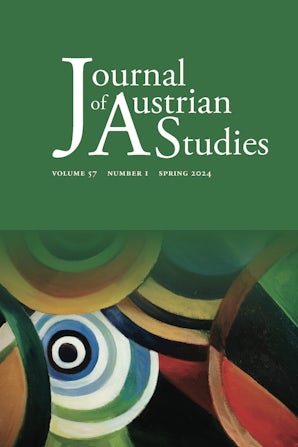
Volume 57, Number 1 (Spring 2024)
Contents
Articles
In Memoriam: Robert Dassanowsky
Vom “Flugtraum” zum “Luftmord”: Der österreichische Luftdiskurs im Kontext des Ersten Weltkrieges
Monika Szczepaniak
“Wouldn’t It Be Smarter to Let the Malay Colonize Europe?” Postcolonial Critique, Antiglobalism, and Racism in the Travel Books of the Bohemian-German Author Richard Katz (1888–1968)
Jeroen Dewulf
Neocolonial Echoes in the Heart of Darkness: Peter Kubelka, Ulrich Seidl, and the Distrust of Sound
Arne Koch
Winner of the 2022 JAS Graduate Student Essay Prize
Assimilation as Abjection in Franz Kafka’s “Ein Bericht für eine Akademie”
Christian Schuetz
JAS Extra
Von November bis März (ABSTECHEN)
A Prose Poem by Angelika Reitzer and an Interview with the Author
JAS Editors and Angelika Reitzer
Reviews
Ágoston Berecz, Empty Signs, Historical Imaginaries: The Entangled Nationalization of Names and Naming in a Late Habsburg Borderland.
Andrew Behrendt
Ion Lihaciu, Czernowitz und die Bukowina in frühen Dokumenten und Reiseberichten: Vom Werden eines habsburgischen Kronlandes (1775–1875).
Joseph W. Moser
Paul Miller-Melamed, Misfire: The Sarajevo Assassination and the Winding Road to World War I.
Eric Grube
Irma Duraković, TraumLeben: Traumpoetiken der Wiener Moderne.
Vincent Kling
Ilona Sármány-Parsons, Die Macht der Kunstkritik: Ludwig Hevesi und die Wiener Moderne.
Patrick Werkner
Andrea Newsom Ebarb, Investigating Franz Kafka’s “Der Bau”: Towards an Understanding of his Late Narrative in a Jewish Context.
Pamela S. Saur
Alexander Kling and Johannes F. Lehmann, eds., Kafkas Zeiten.
Ruth V. Gross
Marlen Eckl and Jeffrey B. Berlin, Stefan Zweig und Jakob Wassermann: Eine Lebensbekanntschaft im Licht ihrer Korrespondenz (1908–1933).
Birger Vanwesenbeeck
Paul Michael Lützeler und Thomas Borgard, Hrsg., Hermann Broch und die österreichische Moderne. Literatur, Kunst und Wissenschaftsphilosophie.
Martin A. Hainz
Eva Plank, Hrsg., Stefan Zweig. Zwiesprache des Ich mit der Welt.
Walter Tschacher
Bernhard Hachleitner, Alfred Pfoser, Katharina Prager, and Werner Michael Schwarz, eds., Die Zerstörung der Demokratie: Österreich März 1933 bis Februar 1934
Vincent Kling
Irene Husser, Elfriede Jelineks Theater des (Post-) Politischen: Agonistik der Gegenwartsliteratur.
Peter Höyng
Margarete Lamb-Faffelberger and Gabriele Petricek, eds., Passages: Crossings, Borders, Openings: In Conversation with Austrian Writers: The Austrian-American Podium Dialog.
Aaron Carpenter
Rosie Goldsmith et al., eds. The Austrian Riveter: Writing from Austria.
Vincent Kling
Michael Pilz and Dirk Rose, eds., Sigurd Paul Scheichl: Literatur in Österreich und Südtirol. Ein Panorama in 30 Aufsätzen.
Raymond L. Burt
Anita McChesney, Texas Tech University
Peter Meilaender, Houghton College
Thomas Ballhausen, Universität Mozarteum Salzburg, Salzburg
Steven Beller, Independent Scholar, Washington DC
Dieter Binder, Universität Graz
Michael Burri, Bryn Mawr College
Diana Cordileone, Point Loma Nazarene University
Robert Dassanowsky, University of Colorado at Colorado Springs
Daniel Gilfillan, Arizona State University
Christina Guenther, Bowling Green State University
Susanne Hochreiter, Univesität Wien
Vincent Kling, LaSalle University
Martin Liebscher, University College London
Dagmar Lorenz, University of Illinois at Chicago
David Luft, Oregon State University
Imke Meyer, University of Illinois at Chicago
Oliver Speck, Virginia Commonwealth University
Heidi Schlipphacke, University of Illinois at Chicago
Janet Stewart, University of Aberdeen
Gregor Thuswaldner, North Park University
Trending Articles - Summer 2021
"Quoting the Language of Nature in Karl Kraus's Satires" (Vol. 46 No. 1, 2013)
"On Display: Conditions of Critique in Austria" (Vol. 46 No. 1, 2013)
"Pathogenic Polemics: Heldenplatz and the 'Bernhard Virus'" (Vol. 46 No. 1, 2013)
"'Alles Ist Unter der Oberfläche Noch Lebendig': Penetrating the Schöner Schein through Satire in Josef Haslinger's Opernball and Robert Menasse's Schubumkehr" (Vol. 46 No. 1, 2013)
"The Beetle in Pain: Private Trauma in Ingeborg Bachmann's Malina"(Vol. 53 No. 4, 2020)
This list of peer-reviewed materials features articles on many topics spanning Globalization, Genocide, Religion, Diaspora Communities, and other aspects on the topic of Migration.
Click the link above to view this journal's advertising rates & options!
Libraries face a dilemma: the number of books, journals, and other information resources available to offer to their patrons is growing faster than their acquisitions budgets. Decisions about which new materials to add in a given year are influenced by a number of factors, not the least of which are whether they are aware of the existence of a resource and the value that resource would bring to those who rely on the library. Librarians often appreciate the input of users in gathering the information they need to make those evaluations. There is no one right way to share information about a particular journal with a library. Some institutions have formal procedures for submitting acquisition requests, others rely on regular communication between subject area librarians and the departments they serve, and some have no specifically defined method. You are in the best position to determine the most appropriate method for approaching your library with a request for the addition of a journal to its collection. However, we have developed a library recommendation form as one tool you can use to provide your library with relevant information. The form contains basic information about the journal: a description, its print and electronic ISSNs, frequency of publication, pricing, print and electronic options, and ordering information. It also includes a few questions for you to complete that address your evaluation of the journal's value. If you choose to use the form, fill it out then send it to the appropriate individual at your library. Do not return it to the University of Nebraska Press.